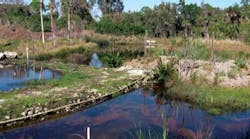Nutrient removal pilot study reduces phosphorus in wastewater effluent to Nashua River
SALT LAKE CITY, UT, Feb. 28, 2012 -- A pilot study at the Clinton Wastewater Treatment Plant (WWTP) in Clinton, Mass., has successfully demonstrated the ability to treat effluent water to less than 0.1 mg/L of total phosphorous (TP).
The Clinton WWTP provides advanced wastewater treatment, including nutrient removal, for the towns of Clinton and Lancaster, Massachusetts. The plant effluent is discharged into the Nashua River where phosphorus reduces oxygen levels through eutrophication, which can inhibit aquatic life. With an average daily flow of 3 million gallons per day (MGD), Clinton removes phosphorus through a conventional activated sludge system followed by chemical coagulation.
The current regulation for the Clinton WWTP states that 1.0 mg/L of TP can be discharged into the Nashua River. The Massachusetts Department of Environmental Protection has released a draft National Pollutant Discharge Elimination System permit stipulating phosphorus regulation changes to begin in 2014. The permit requires that the facility discharge less than 0.15 mg/L of TP from April through October, and less than 1.0 mg/L between November and March. To provide a safety margin and to improve environmental quality, Clinton set a treatment goal of <0.1 mg/L phosphorus year-round.
In the pilot study, WesTech Engineering (Salt Lake City, UT) successfully utilized the SuperDisc™ Disc Filter in multiple dosing rates of alum, ferric chloride, and various polymers to optimize filtrate quality and chemical dose. Results showed that with the addition of a polymer and ferric chloride, phosphorus levels were consistently below the goal of 0.1 mg/L TP under all plant conditions while operating with an efficiency between 95% and 97%.
Through the range of loading rates tested, the SuperDisc handled elevated hydraulic loading rates while maintaining unvaried and consistent phosphorus removal performance. This type of filter is used for effluent polishing, water reuse, process water filtration, and cooling water filtration. This pilot study is another example illustrating that the WesTech SuperDisc effectively and efficiently removes total phosphorus.
"We are pleased to demonstrate that disc filtration is a viable technology for treating phosphorus levels below 0.1 mg/L," said Brad Hansen, WesTech Wastewater Filtration Group Leader. "This provides a great option to engineers and plants that could benefit from features of the disc filter, including its ability to treat large flows in a small footprint, operate at heads less than 12 inches, and achieve low backwash rates."
Click here for a full report on the pilot study >
###

